9+ Things to Make with Purple Dead Nettle (+printable!)
Discover over 9 creative and practical things you can make with the bounty of purple dead nettle growing in your lawn or vegetable beds!
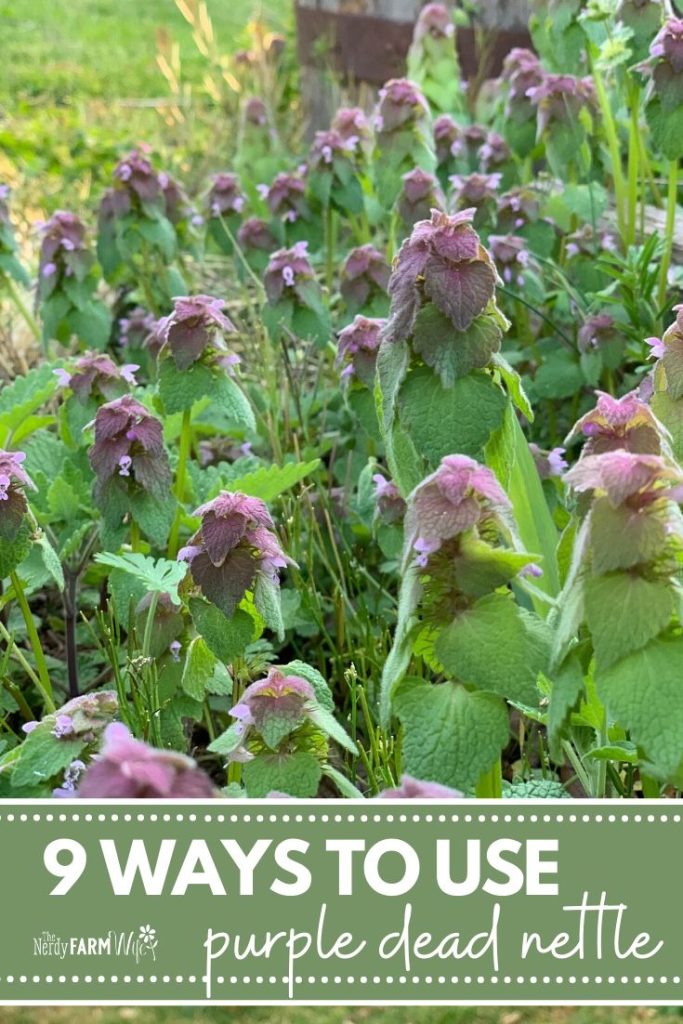
Purple dead nettle (Lamium purpureum) is an early spring weed that you often find growing in lawns and garden beds.
It grows like gangbusters in my garden, which I love (and so do the bumblebees!), but unfortunately, I have to clear some out every year to make space for planting vegetables too.
It’s a nutritious edible and has a ton of healthful benefits and uses, so I don’t just toss it all to the chickens – I save some for our use too!
We especially use a lot of the salve – one of my children has frequent aches related to hypermobility and the structure of her joints, and reports it’s very effective for her particular type of pain.
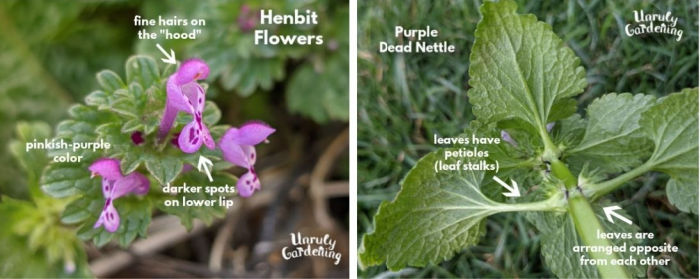
Identifying Purple Dead Nettle
It’s sometimes confused with henbit (Lamium amplexicaule) or possibly ground ivy/creeping charlie (Glechoma hederacea).
For in depth information on telling henbit and purple dead nettle apart, please see the article at our family’s website – Unruly Gardening:
Here are some foraging tips for purple dead nettle:
- has hairy leaves, turning purple towards the tips of the plant
- opposite leaves are densely crowded together along stem
- has a square stem, indicative of being in the mint family
- purple flowers, bilateral with lips
- there are no toxic look-a-likes while the tops are purple and flowering
If you’re pregnant or nursing, it’s best to avoid internal use of purple dead nettle, unless a qualified healthcare provider recommends otherwise.
Purple Dead Nettle “Cheat Sheet”
Here’s an informational sheet about purple dead nettle that I sent to my newsletter subscribers for a couple of years. This year, I decided to make all of my Plant Spotlight printables freely available on my website for all to enjoy!
Please share them with friends and especially the younger generation, helping to carry on the legacy of using what grows around you.
(You may print copies of my free printables to share with scout groups, garden clubs, etc. Just make sure the copyright information stays attached at the bottom and do not sell them for personal gain. Links WILL change as printables get updated over time – please link to this page when sharing, not the exact printable to avoid broken links.)
If you’re a beginner forager, make sure your purple dead nettle has flowers and purple tops before gathering to ensure you’re getting the correct plant.

How to Dry Purple Dead Nettle
Some of the projects below require dried plants. Here’s how I dry mine:
- Gather the plant when it’s dry with no rain or dew on it.
- Turn each piece upside down and shake or tap against your hand, to dislodge the ants that are often found inside.
- Bring indoors and spread the plants in a single layer over a clean dishtowel or paper towel.
- Allow to air dry for several days until completely dry.
- You could also use a dehydrator if you’d like, set to 95 to 115 degrees F, for 1 to 4 hours. (source)

Ways to Use Purple Dead Nettle
1. Edible Spring Food
Purple dead nettle can be eaten fresh, sprinkled in salads, or used in pestos.
To be honest, I think the fresh leaves taste like a cross between spinach and overcooked green beans that have sat out at a buffet all day, so I like them only sparingly incorporated into food products. (But that’s just me!) :)
Also, watch out for little ants hiding within. When I pick purple dead nettle, I turn each sprig upside down and tap it lightly to make sure to dislodge the ants before carrying inside.

2. Tincture
Stinging nettle (Urtica dioica) is often used in preparations to help with seasonal allergies.
While purple dead nettle is not the same plant as stinging nettle, it too is used by some to help with allergies.
One way to incorporate purple dead nettle into your life is by making tea, but a tincture has a much longer storage life and can be easier to take.
To make, combine 1/4 cup chopped purple dead nettle + 1/2 cup (118 ml) high proof vodka.
Shake well and store in a cupboard for several weeks before straining. Store in a cool dry area out of direct light.
I microdose tinctures for my family and only use a few drops at a time for inflammation and allergies, and combine the tincture with about twice as much raw local honey for easier compliance in taking. You may wish to work up to a full dropperful of tincture at a time; each individual is unique in their response.
If you have medical concerns, or are pregnant or nursing, check with a healthcare provider before using.
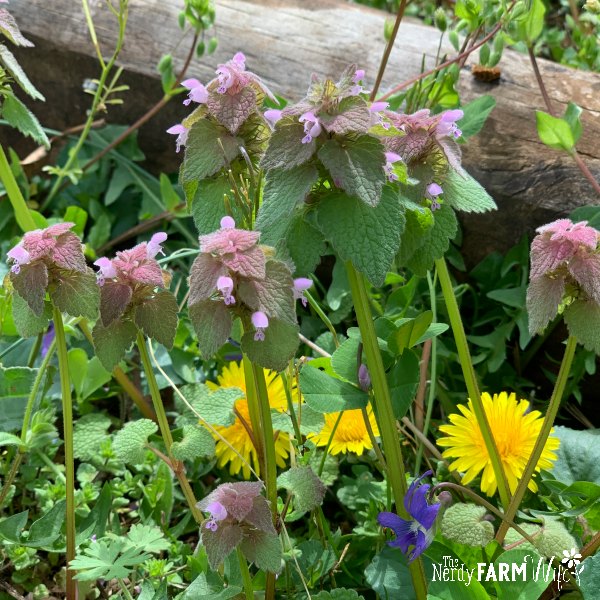
3. Poultice for Small Wounds/Insect Bites
An old fashioned spit poultice, is pretty much what it sounds like!
If you’re out and about enjoying the outdoors, and you get a pesky insect bite or small wound, you can chew up the leaves of certain plants to apply as a poultice to ease the sting or itching, or slow the bleeding.
Plantain (Plantago major) leaves are a commonly used green weed that’s great for this purpose, as well as yarrow (Achillea millefolium). Purple dead nettle can be added to that list as well.
Just grab a few leaves, masticate (chew) them up a bit, and apply the resulting leaf pulp to the offending area. Spit poultices can be quite effective and are a useful first aid skill to know.
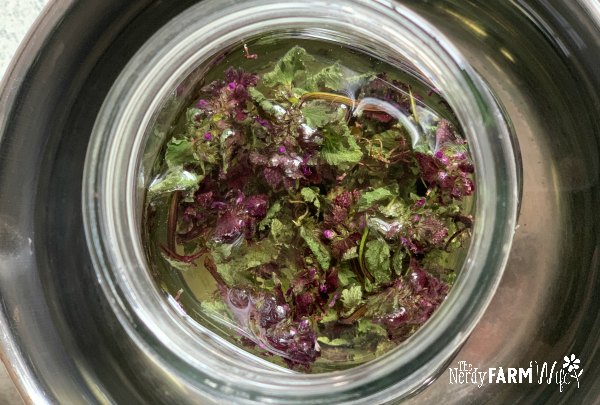
4. Infused Oil
Steeping dried herbs in oil creates a beneficial infused oil that can be used to make salves, balms, lotions, and more.
To make purple dead nettle infused oil, you’ll need about twice as much oil as dried crumbled purple dead nettle.
- Fill a glass canning jar 1/4 to 1/2 of the way with crumbled up dried purple dead nettle. (You can also mix in other dried herbs such as calendula, yarrow, etc, depending on what you want to make.)
- Fill the jar almost to the top with your chosen oil and stir – I used apricot kernel oil for a slightly lighter feel, but olive or sunflower oil can be good for most skin types too. You can also mix and match your favorite oils.
For a quick infusion:
- Set the uncovered jar down into a saucepan containing a few inches of water, forming a makeshift double boiler of sorts.
- Place the pan over a low burner and heat for around 2 or 3 hours.
- Don’t allow the water to evaporate out of the pan, and monitor the oil while it’s heating.
- Remove from the heat and strain out enough oil for your recipe when needed. You can top off the jar with more oil and allow it to continue infusing the slow way until needed again.
For a slow classic infusion:
Instead of infusing over heat, put a lid on the jar and tuck it away in a cabinet or on a shelf and let it steep for at least 4 to 6 weeks, shaking occasionally as you remember to.
For the sunny window method:
Place the jar of oil and dried herbs in a sunny window to infuse for about a week or two, then transfer to a darker spot to infuse another week or so. The heat from the sun gently accelerates the infusing process. We don’t want to infuse in the window for too long though, since too much sunlight could fade out the herbs.
Strain and store any remaining infused oil in a dark spot or cabinet out of direct sunlight and heat. Shelf life should be about 1+ year.
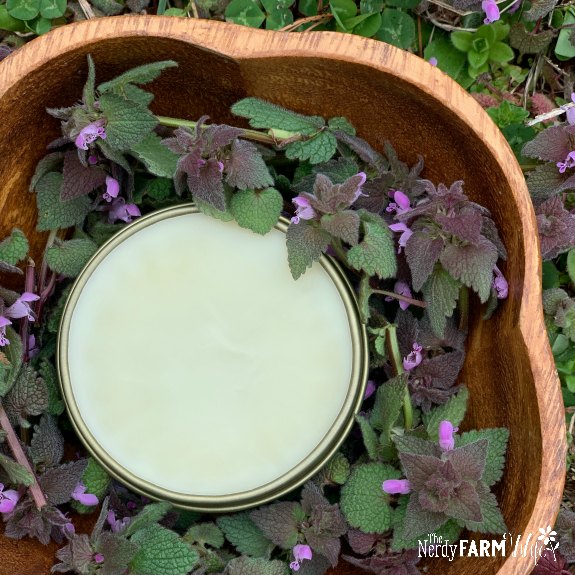
5. Salves & Balms
Externally, purple dead nettle is anti-inflammatory, making it good for aches and pains, and also antimicrobial, which makes it a helpful component for first aid salves.
Visit my article, How to Make Purple Dead Nettle Salve (3 recipes), for more information on making:
- Basic Purple Dead Nettle Salve
- First Aid Purple Dead Nettle Salve
- Aches & Pains Purple Dead Nettle Salve
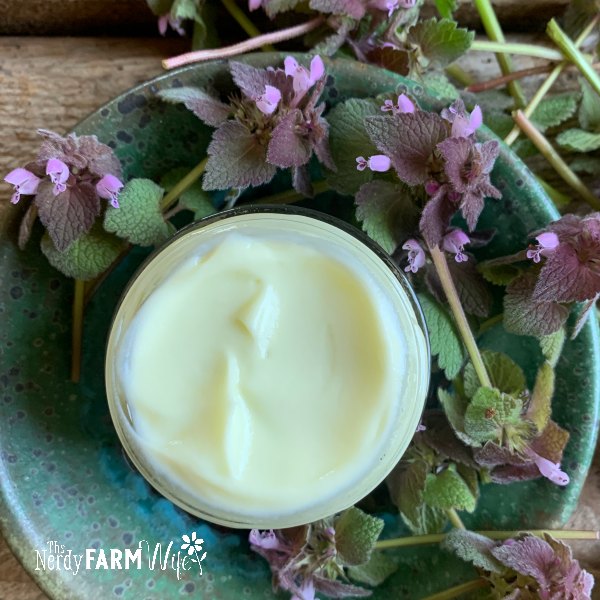
6. Use in Lotions & Creams
Purple dead nettle infused oil makes an excellent addition to lotions and creams designed for those with itchy or inflamed skin conditions. With its free radical scavenging properties (see sources at bottom of this article), it could also be nice to include in daily wear or antipollution skincare products.
You can swap the infused oil for plain oil in any lotion or cream recipe, but here’s one that I recently made and really enjoy.
Unrefined hempseed oil (Cannabis indica) gives the lotion a soft natural green color and is rich in essential fatty acids. I added it to the recipe because it moisturizes and balances most skin types, plus may be helpful for eczema, psoriasis, dermatitis, or damaged skin.
You’ll need an accurate scale (I use THIS ONE) to make this recipe.
Ingredients needed for Hemp & Purple Dead Nettle Lotion:
- 64 g distilled water
- 12 g sunflower oil – infused with purple dead nettle
- 6 g hempseed oil
- 7 g cosmetic butter (I used murumuru, but mango or shea would be nice too)
- 7 g vegetable emulsifying wax
- 4 g Leucidal SF Complete (natural, organic compliant preservative) OR (1 g Optiphen Plus + additional 3 g distilled water)
Directions to make:
- Weigh the distilled water into a heatproof container.
- Weigh the infused oil, hempseed oil, murumuru (or mango or shea) butter, and vegetable emulsifying wax in a separate heatproof container. (I use two small 4 oz jelly/canning jars.)
- Place both jars down into a saucepan containing a couple inches of water, forming a double boiler of sorts.
- Turn the burner to medium low and heat until the wax is fully melted – about 10 to 15 minutes.
- Pour the hot water and melted oil/butter/wax together into a clean jar.
- Using a fork (or one beater attached to a hand mixer), stir the lotion briskly for about a minute, then set aside to cool for 5 minutes, checking and stirring frequently.
- To speed the cooling process, place your mixing container in a bowl of ice water. Stir occasionally, for around 30 seconds at a time, as the lotion cools and thickens.
- Check the temperature. Once it’s below 104°F (40°) add the preservative and mix well. It may take up to 24 hours for your lotion to reach its final thickness.
- Pour or spoon into jars or bottles. Make sure the lotion is completely cool before putting tops or lids on, to avoid condensation (which can more easily promote mold.)
7. Throat Spray
Combine tinctures and raw honey to create simple effective sprays to help soothe itchy, scratchy, or sore throats.
Purple dead nettle tincture may be a helpful addition to your throat spray creations!
Read more at my article, DIY Herbal Honey Throat Spray Recipe.
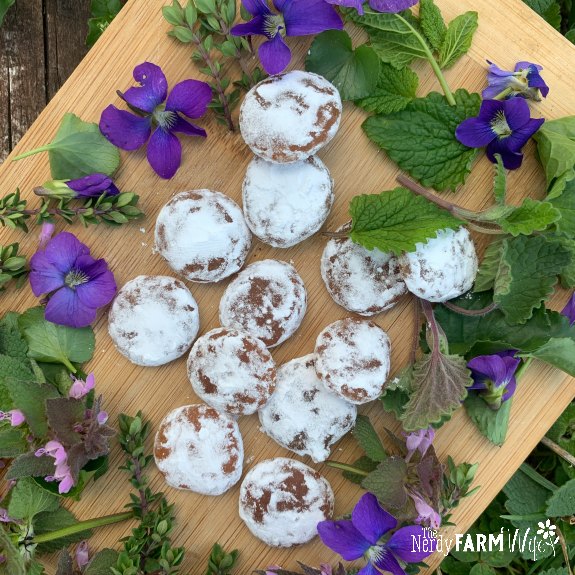
8. Cough Drops
Purple dead nettle can be included with other herbs to make your own yummy throat soothing herbal cough drops.
To make, you’ll need:
- honey
- sugar
- herbal tea
- peppermint extract (optional, for flavor)
- tinctures (optional, for added herbal properties)
For the full recipe and more details, visit my DIY Herbal Cough Drops article.

9. Natural Colorant for Melt & Pour Soap
Purple dead nettle gives a pretty pale green or yellow-green color when infused in meltable soap base. (I haven’t experimented with it in cold process soap yet, but that’s on my to-do list!)
Above is a photo of various herbal infused soaps taken from my Easy Homemade Melt & Pour Soaps print book.
Here’s how you can infuse soap base:
You’ll need:
- 1/8 cup chopped fresh purple dead nettle
- 1/4 tsp water
- 4 oz (113 g) white melt and pour soap base
Place the purple dead nettle in the bottom of a half-pint or similarly sized heat proof canning jar or container. Add the 1/4 tsp water, then fill the jar with soap base.
If you’d like to jump start the infusing process, you can microwave the jar for about 20 seconds, or until the soap starts melting.
Next, place the jar down into a small saucepan containing a few inches of water. Cover the jar with a lid and allow it to infuse for about 25 to 35 minutes, or until the soap has taken on a green color from the plants.
Remove from heat and pour the hot soap base through a strainer, into silicone soap molds.
Once completely cooled and hardened, remove from the mold and wrap airtight in plastic wrap, or biodegradable shrink wrap.
You can enjoy your soap right away!
Even More Ideas!
Other ways you could include purple dead nettle in your life:
- Make Purple Dead Nettle Lotion Bars.
- Try using the infused oil when creating your own lip balm recipes or body butters.
- If you enjoy natural dyes, check out Timber Creek Farm’s lovely tutorial on using purple dead nettle to dye wool.
References & Sources
Five New Phenylethanoid Glycosides from the Whole Plants of Lamium purpureum L – compounds in Purple Dead Nettle have potent free radical scavenging activity
Antioxidant and free radical scavenging activities of some medicinal plants from the Lamiaceae. (including Purple Dead Nettle/Lamium purpureum)
In vivo anti-inflammatory and antinociceptive actions of some Lamium species. Several Lamium species have been used to relieve pain in arthritic ailments in Turkish folk medicine.




Perfect timing! I’ve been seeing the purple dead nettle when I go foraging for greens, and wondered if it had a use. Thank you!
Hi Jane! So happy to hear you enjoyed the article on using purple dead nettle! :)
same with me! I have tons of it, I figured it was from mint family but it tasted terrible (not at all minty) I’m very happy to know it is useful! Perfect timing!
This is a question, rather than a comment ( although I love reading and learning from the information you provide). I’m VERY new to natural wellness choices and wonder if I can replace purple dead nettle with my copius ( and invasive) amount of yellow dead nettle? Thank you in advance for your generosity in sharing your knowledge with us all.
Cheers,
Lora
Hi Lora, What a great question! We don’t have yellow dead nettle so I wasn’t familiar with it, but going by a few sites I briefly looked at like:
http://www.eattheweeds.com/golden-dead-nettle/
I would definitely give it a try!
You could also do a google search for:
pubmed LAMIUM GALEOBDOLON
to find more information.
Just doing that quickly, I found this study:
https://www.ncbi.nlm.nih.gov/pmc/articles/PMC6571824/
which mentions:
“Aerial parts decoction of L. galeobdolon traditionally used for fever, malaria, warts, constipation, hair loss, rheumatism, dandruff, hemorrhage [83,84] depression, nerve tonic [85].”
and
“At this point, it is worth mention L. galeobdolon L., commonly known as the ‘yellow archangel, that has good potential as an ingredient for the preparation of functional foods. This species is a wildflower widespread in Europe and has been introduced elsewhere as a garden plant. An ethnobotanical study carried out on 49 edible wild plants traditionally harvested and consumed in a region of the Basque Country, Northern Spain, described the recreational use by children of nectar sucked from the base of L. galeobdolon flowers. Different benzoxazinoids (BXs), present as glucosides (Figure 3), have been identified in the yellow archangel.
These compounds represent a class of indole-derived plant metabolites that work in defense against numerous parasites and pathogens [136]. Many recent studies have reported antimicrobial, anticancer, reproductive stimulatory effects, system stimulators central nervous system, and reduction of appetite and weight of BXs derivatives and their derivatives [137].”
It’s tha start of Sprang an I hav’ bin watch’n our purple dead nettle grow’n it’s sweet lil self rite’on up on our Farm :) .. Thank’Yu fer share’n this an all Yu do with us .. I LOVE Yer Books.. I’v had 101 Easy Home’made Products Book fer a couple of years now an LOVE IT… I jus came a’cross Yer new Book Big Book Of Home’made Products a day bac’ an ordar’d it .. Im’ma study’n Herbalist an make our own Tinc’tures, Salves an Lotions , plus no mor’ pharma with’in this Farm .. I’m Thank’ful fer Folks like Yu an git’n bac’ deep’r to my Mountain Roots .. Yer my favor-ite Home’made Herbalist an I truly Thank’Yu .. Shalom from Hill’Top Hollar ~ Mountain Daughter
Hi Mountain Daughter, Thanks for the kind words & so happy you like the books! :) Happy (almost) spring!!
I just dry and put in a jar. Then pull out a few, cover with boiling water for a nice tea. I do the same for the dandelion tops. I also make dandelion infused olive oil and dandy wine.
Hi Tracie, Great ideas! Thanks for sharing! ❤
Hello!! Thank you for all the great information here! I’m just learning about herbs and tinctures and such and this was very helpful. Quick question, for the tincture would I dry the dead nettle first or can I use it fresh? Thanks again!
Hi Julianna, I’m so glad you found the information helpful! If possible, I like to use fresh dead nettle for tincture, but you can use dried if that’s what you have on hand. ?
Psst psst psst I see wild violets in the pictures which are also growing in my yard. Do you have info on those? Are they also useful? *excited bouncing*
Hi Savannah, Yes! I do have information on using wild violets! ?
You can find 10+ ways to use the the flowers & leaves + there’s a Violet Plant Spotlight printable in that article too:
https://thenerdyfarmwife.com/10-things-to-make-with-violets/
Can I give the tincture to my children ages 10 -15 how would I do the dose. My children suffer from horrible allergies every year and seems like over the counter medication doesn’t help very well.
Hi Melissa! I can’t prescribe exact doses, but I can relay that I worked with a naturopath when my kids were growing up & she had me dose them a few drops of tincture at a time, several times a day.
We usually mixed with a spoonful of honey, or a few drops into a glass of ginger ale or juice.
Having some purple dead nettle tea right now. I’ve chewed a few sprigs each of the last few days and it’s mostly eliminated my morning hacking from post nasal drip. We’ll see how the tea works.
Hi Darren, That’s great to hear that chewing on the purple dead nettle sprigs has been helpful for your allergies!
That such a nice simple way to get the dose in. I hope the tea was useful too!
Thank you so much for this! It brought back memories of my childhood in Germany. We would eat the spring greens of nettles (dry and stinging), dandelion, sorrel, and many others during and after WWII, when food was scarce.
Hi Heidi, Thanks for sharing those memories with us! ❤
How long do tinctures stay good? Are Mason jars best fir storing them? Thank you!
Hi Jennifer! Tinctures stay good at least a year; I’ve kept some for 2+ years.
Usually I try to make up a fresh batch each year though, as long as there’s fresh plant material to work with.
Yes, mason jars are great to store your tinctures in! That’s where most of mine are kept, though I sometimes use some amber glass dropper bottles for smaller batches. :)
Are you using the stem also, or deleafing? Generally speaking and for the salve?
Hi Kat! Yes, I’m using the whole tops of the purple dead nettle – flowers, leaves, and stems are all fine to use. :)
I made some of this for my son’s allergies as a tea mixed with lemon balm. He says it’s helpful. Now I find I also have spotted dead nettle available and wonder if they have the same properties?
Hi Paula, I’m so glad this helped! I’m unsure about spotted dead nettle’s exact properties. They likely overlap with purple dead nettle, but I’m not sure how much.
I would do a little research on the plant by its Latin name – Lamium maculatum – and double check that it’s edible.
If so, you could do a small test batch and see how it goes! :)
Question, do the tops have to be purple before picking? I have some in my yard but only a few are actually purple on top, most are still green. (Please tell me green is still ok, seeing as I already picked a bag full.)
Hi Kari! Some of the tops will stay green. As long as they’re flowering so you can 100% identify them without purple tops, they are still fine to use.
The purple tops are just a sure fire way to identify if you’re not sure what you have. :)